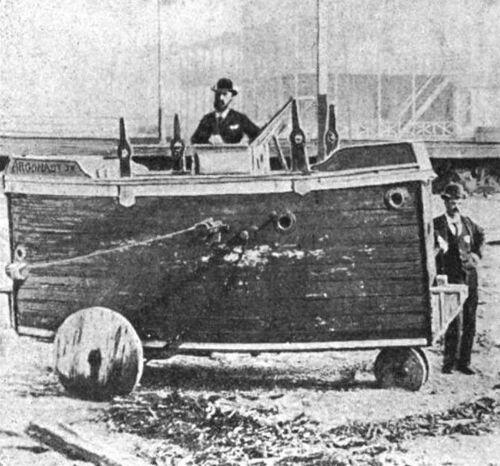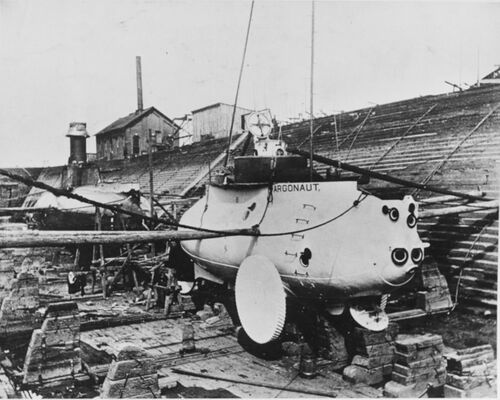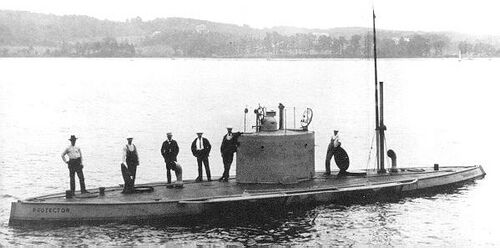Simon Lake non-Navy Submarines: Difference between revisions
Pbcjohnston (talk | contribs) →Argonaut Junior: Added photo and caption |
Pbcjohnston (talk | contribs) Added captions |
||
| Line 13: | Line 13: | ||
===<big>Argonaut Junior</big> === | ===<big>Argonaut Junior</big> === | ||
[[File:Lake Argonaut_Junior.jpg|left|500px | [[File:Lake Argonaut_Junior.jpg|left|500px]] | ||
<div style="text-align: justify;"><span style="color:#00008B">This is Simon Lake's first submarine, the wooden and canvas hulled Argonaut Jr. It was 14 feet long with a four foot beam. Built entirely by hand it had two layers of yellow pine boards that sandwiched a rubberized canvas sheath that made it watertight. It had no engine or means of propulsion. It would sink to the bottom and rest on its wheels. Operators inside would hand crank the wheels to move it along the bottom. It also had a diver lock-out chamber. More than anything else it was a proof of concept vessel that gained Lake enough recognition that he was able to secure funding for a much more ambitious follow-on vessel.</ | <div style="text-align: justify;"><span style="color:#00008B">This is Simon Lake's first submarine, the wooden and canvas hulled Argonaut Jr. It was 14 feet long with a four foot beam. Built entirely by hand it had two layers of yellow pine boards that sandwiched a rubberized canvas sheath that made it watertight. It had no engine or means of propulsion. It would sink to the bottom and rest on its wheels. Operators inside would hand crank the wheels to move it along the bottom. It also had a diver lock-out chamber. More than anything else it was a proof of concept vessel that gained Lake enough recognition that he was able to secure funding for a much more ambitious follow-on vessel. | ||
<small>Photo courtesy of Wikipedia.org</small> | |||
[[File:Red bar sub new.jpg]] | [[File:Red bar sub new.jpg]] | ||
<div style="text-align: justify;"><span style="color:#000000"> | |||
=== <big>Argonaut 1</big> === | === <big>Argonaut 1</big> === | ||
[[ | </div> | ||
<div style="text-align: justify;"><span style="color:#00008B"> | |||
[[File:Lake Argonaut 1.jpg|left|500px]] | |||
<div style="text-align: justify;"><span style="color:#00008B">Having secured investor funding, Lake built a follow-on vessel that He named Argonaut 1. Metal hulled and powered by a 30 hp gasoline engine, it was a tremendous advance over the Argonaut Jr. It also proved to be amazingly seaworthy, racking up over 2,000 miles of surface and submerged running, including an open-ocean transit from Cape May to Sandy Hook, NJ. It had wheels for rolling along the bottom and again a diver lockout chamber. From a military standpoint Lake marketed it as being able to stealthily enter a minefield, send a diver out, and cut mine cables. The same diver would also be able to gather intelligence on other underwater defenses and conduct salvage work. It had no other offensive capability. Pitched to the Navy, Lake failed to impress them with the boat's capabilities and the Navy did not buy it. Refusing to give up on the idea of rolling along the bottom, Simon Lake continued to build submarines with wheels up through 1909, when he built the [[G-1|'''G-1 (Submarine No. 19½)''']] for the Navy. The Navy however, was never impressed with the capability and refused to buy any more submarines with wheels. The concept died with G-1, only to be ironically revived by the nuclear-powered special operations submarine NR-1 in 1969. | |||
This photo shows Argonaut 1 in drydock at the Columbian Iron Works facility at Locust Point, near Fort McHenry, in Baltimore, Maryland in approximately 1898. The large forward wheels and viewports at the bow are very apparent. Just below the forward viewports is the open diver's hatch. | |||
It is interesting to note that there is another submarine in the dock with the Argonaut. Behind her is the Holland submarine Plunger of 1895, also known as the Holland V. It was an experimental submarine built by Holland under a Navy contract. Steam boiler powered, it was a complete failure and it was never accepted by the or commissioned into service. Never completely finished it lingered at the Holland facility at New Suffolk, NY until it was scrapped in 1917. | |||
<small>Photo NH 57030 courtesy of NHHC.</small> | |||
[[File:Red bar sub new.jpg]] | [[File:Red bar sub new.jpg]] | ||
<div style="text-align: justify;"><span style="color:#000000"> | |||
=== <big>Protector</big> === | === <big>Protector</big> === | ||
[[File:Protectr.jpg|left | </div> | ||
<div style="text-align: justify;"><span style="color:#00008B">Lake's Protector. This photo was most likely taken shortly after her completion in late 1902. The location is | [[File:Protectr.jpg|left|500px|National Archives photo]] | ||
<div style="text-align: justify;"><span style="color:#00008B">Lake's Protector. Another submarine that Lake attempted, but failed, to sell to the U.S. Navy. Unable to arouse interest in this boat in the U.S., Lake sold the boat to Russia, who renamed it Osetr. This photo was most likely taken shortly after her completion in late 1902. The location is near his company yard in Bridgeport, CT. Note guards at side of vessel to protect the diving planes from damage.</span> | |||
[[Protector1|See more Protector photos]] | [[Protector1|See more Protector photos]] | ||
[[File:Red bar sub new.jpg]] | [[File:Red bar sub new.jpg]] | ||
<div style="text-align: justify;"><span style="color:#000000"> | |||
=== <big>Simon Lake XV/Lake/Defender</big> === | === <big>Simon Lake XV/Lake/Defender</big> === | ||
</div> | |||
[[File:the lake docked-cleaned.jpg|left|500px|Photo in the private collection of Ric Hedman.]] | [[File:the lake docked-cleaned.jpg|left|500px|Photo in the private collection of Ric Hedman.]] | ||
<div style="text-align: justify;"><span style="color:#00008B">After selling Protector to the Russians, Simon Lake headed to Europe for several years, designing and building submarines for Austria and Russia. Lake returned to the states in 1906, goaded into building a submarine for demonstration to the Navy by the 1906 Naval Appropriations Bill that allocated $500,000 in money for submarines. The result was this submarine, initially called Simon Lake XV, then simply Lake. Entered into the competition against the Electric Boat design [[C-1|'''Octopus (Submarine No. 9)''']], the Lake lost the competition. Refusing to give up Lake rebuilt the boat into a salvage vessel and renamed it Defender. It is a strange tale and the whole story can be | |||
<div style="text-align: justify;"><span style="color:#00008B"> | |||
[[Defender|See more Defender photos]] | [[Defender|See more Defender photos]] | ||
Revision as of 17:35, 21 October 2023
A brief history of Simon Lake
Argonaut Junior

Photo courtesy of Wikipedia.org
Argonaut 1

This photo shows Argonaut 1 in drydock at the Columbian Iron Works facility at Locust Point, near Fort McHenry, in Baltimore, Maryland in approximately 1898. The large forward wheels and viewports at the bow are very apparent. Just below the forward viewports is the open diver's hatch.
It is interesting to note that there is another submarine in the dock with the Argonaut. Behind her is the Holland submarine Plunger of 1895, also known as the Holland V. It was an experimental submarine built by Holland under a Navy contract. Steam boiler powered, it was a complete failure and it was never accepted by the or commissioned into service. Never completely finished it lingered at the Holland facility at New Suffolk, NY until it was scrapped in 1917.
Photo NH 57030 courtesy of NHHC.
Protector

